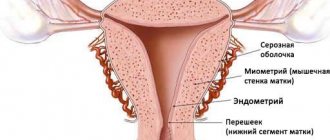The appearance of polyps in the uterus is accompanied by intense blood rejection during menstruation and discharge after intimacy. This pathology is caused by a lack of progesterone in the body and an excess of estrogen. Duphaston for endometrial polyp will come to the aid of nulliparous girls or women for whom surgery is contraindicated.
If polyps were surgically removed, this drug is often still prescribed after surgery. Its action in this case is aimed at preventing the appearance of tumors in the future.
Description and characteristics
Duphaston is a synthetic analogue of progesterone synthesized in a woman’s body. With the help of this medicine, you can not only get rid of polyps in the uterus, but also correct the hormonal balance that causes pathologies such as miscarriage, the threat of early miscarriage, infertility, and cure endometriosis. It is able to regulate the menstrual cycle if the absence of menstrual periods for several months is caused by hormonal imbalance.
If the polyp has a fibrous structure, then it needs to be removed only surgically. Treatment with Duphaston in this case will not give results. And if the neoplasm is glandular, then hormonal therapy will bring good results.
Therapy with this remedy is not always effective. The doctor prescribes it, taking into account the medical history of each individual woman.
How are polyps of the uterus and cervical canal treated?
This pathology is the most common among diseases of the female reproductive system. It is more common in patients before menopause, but sometimes occurs in very young girls. The consequences of polyps can be chronic inflammation, bleeding, infertility and even uterine cancer, which is why it is so important to diagnose and get rid of the pathology in time.
In order to cure a disease associated with the appearance of a formation, you can go in 2 ways:
- Remove the growth surgically.
- Eliminate the causes of the pathology with medication.
The following are considered prerequisites:
- Hormonal imbalance with low progesterone levels;
- Obesity, which in itself creates the situation described above;
- Other endocrine disorders, including diabetes mellitus;
- Abortions, surgeries, difficult pregnancies and childbirths;
- Infectious inflammations.
It is not for nothing that the hormonal cause is in first place on this list, because it is one of the main factors that provoke the appearance of polyps.
Advantages of the drug
Even if surgery can quickly get rid of a tumor, it is still an operation. If it is possible to avoid it, then it is better to do it with the help of Duphaston. This remedy has several advantages:
- Helps eliminate tumors in cases where surgery is contraindicated.
- It is often prescribed as therapy after surgical removal of an endometrial polyp. This is necessary in order to prevent new formations.
- The therapeutic result consists not only in combating abnormal tissue growths and preventing their occurrence, but also in preventing the threat of miscarriage in the early stages of pregnancy, as well as putting the menstrual cycle in order.
This medicine rarely causes side effects and has a beneficial effect on the body, which produces insufficient progesterone. Duphaston for uterine polyp is prescribed only by a doctor, and self-medication can lead to disastrous results.
Hormonal therapy after removal
A course of hormonal therapy after removal of a polyp is not prescribed in all cases - but in the treatment of such forms of polyposis as glandular and glandular-fibrous.
The course of hormonal therapy after hysteroscopy depends on the patient’s age, reproductive plans and individual clinical indicators. Treatment may include the following:
- taking combined oral contraceptives (Yarina, Regulon, Zhanine);
- use in the treatment of gestagens (duphaston, norkolut, utrozhestan);
- use of a hormone-containing spiral (such as Mirena).
One of the most effective remedies from the first category is janine, which combines well with restorative drugs.
Zhanine is prescribed to patients of reproductive age (from 35 to 40 years), the use of Zhanine is regulated by the attending physician. Janine has a good effect on stabilizing the level of progesterone in the body and promotes faster recovery of the patient’s body. The use of Zhanine allows you to preserve reproductive function, has a beneficial effect on a wide range of medical indicators, and normalizes endocrine function.
Directions for use and dosage
This hormonal drug is prescribed to women for various pathologies associated with a lack of progesterone. The doctor outlines the treatment regimen individually in each specific case. On average, a single dose is 5–10 mg, daily – 10–30 mg.
For endometriosis or uterine hyperplasia, take Duphaston 1 tablet 2-3 times a day from the 5th to the 25th day of the cycle.
In the case of a combination of overly enlarged endometrium and uterine fibroids, 10 mg of the drug per day is prescribed, which should be divided into 2-3 doses.
If there is a threat of miscarriage in the early stages, then prescribe 1 tablet 2 times a day. The course of treatment continues until the 20th week, then the dosage is gradually reduced.
If signs of spontaneous abortion appear, the doctor recommends taking 4 tablets at a time. Then - one every 8 hours until the symptoms disappear. It is advisable to take Duphaston until the middle of pregnancy.
Only the treating gynecologist, who is aware of all the characteristics of a particular woman’s body, can prescribe such a serious hormonal drug.
With a polyp in the uterus
In some cases, Duphaston for a polyp in the uterus is used as a substitute for surgery. The doctor makes this decision in a situation where a woman is planning a pregnancy in the near future or surgical interventions are contraindicated for her.
If the formation of a polyp occurs due to a lack of progesterone in the female body, then the hormones of the drug, which are as close to natural as possible, will correct the hormonal imbalance. Therefore, there is a high probability that during treatment the growth inside the uterus will resolve.
Therapy with Duphaston is prescribed for the second half of the menstrual cycle. To combat tumors, it is taken in combination with other drugs. The action of such drugs is aimed at maintaining and restoring hormonal balance in the body. The course of treatment can last up to six months.
After polyp removal
After surgery to remove a benign tumor, hormonal drugs are prescribed in some cases. Duphaston is also included in postoperative therapy.
The course of treatment with Duphaston for endometrial polyps is prescribed by the attending physician. This takes into account:
- woman's age;
- complexion;
- desire to have children in the near future;
- degree of pathology damage;
- individual characteristics of the body.
The drug is prescribed for a period of 3 to 7 months. In order not to further disturb the ratio of hormones in the body, the medicine is not taken in the first phase of the menstrual cycle. Most often, gynecologists prescribe Duphaston from the 16th to 25th day of the cycle.
It must be remembered that this hormonal drug does not stimulate or suppress ovulation. Therefore, when taking it, you should not forget about contraception if pregnancy is not planned.
You also need to remember that it is not recommended to combine this drug with alcohol, as this reduces the effect of the drug and increases side effects.
Advantages and disadvantages
Doctors are divided on whether it is possible and worth taking Duphaston for myomatous formations in the uterus. Some experts claim that the use of this drug contributes to the rapid growth of the tumor, while others are confident that Duphaston helps reduce the size of the tumor.
Based on this, we can conclude that taking this hormonal drug on your own is strictly prohibited.
Speaking about the advantages of the drug, it must be said that this drug is not a contraceptive, so women who are planning a pregnancy or expectant mothers who have been diagnosed with fibroids during pregnancy can take this drug.
In addition, taking Duphaston:
- does not affect blood clotting in any way;
- improves the condition of the endometrium;
- prevents the development of hyperplasia;
- restores ovulation processes.
While taking Duphaston, the following side effects may occur:
- active tumor growth;
- severe headaches;
- in rare cases, uterine bleeding may become more intense;
- disturbances in the gastrointestinal tract;
- dysfunctional disorders in the liver;
- allergic reactions;
- swelling of the limbs and face.
In most cases, the drug is well tolerated, and the presence of side effects can be mitigated by correctly calculating the dose.
Contraindications and side effects
Among the contraindications for taking Duphaston for uterine polyps are:
- Rotor disease;
- Dubin-Johnson syndrome;
- intolerance to any of the components included in the medicine;
- intermenstrual bleeding of unknown nature;
- hypersensitivity to the drug or allergy to it;
- acute or chronic liver diseases;
- lactation period;
- asthma;
- oncology;
- drinking alcoholic beverages. Combining alcohol and Duphaston increases the load on the liver and reduces the effect of the drug. There is also a serious effect on blood vessels, varicose veins and thrombophlebitis are possible.
- non-inflammatory kidney diseases;
- children under 18 years of age.
Side effects from using the drug are rare, but you still need to be aware of them:
- swelling of the mammary glands;
- yellowing of the skin;
- attacks of headache;
- frequent drowsiness;
- skin itching and burning;
- apathetic state, depression;
- bloody vaginal discharge not during menstruation;
- nausea and vomiting;
- bloating, flatulence;
- skin rash.
Unlike other hormonal drugs, Duphaston does not provoke menstrual irregularities and does not have a negative effect on the reproductive function of the ovaries.
If adverse reactions occur, you should consult your doctor. After all, in order to get rid of them, it is necessary to adjust the dose. And if an allergy begins, you need to stop taking the drug.
Preventive actions
To prevent the appearance of not only polyps, but also any other gynecological neoplasms, and also to prevent the growth of already existing pathologies, you need to:
- for the purpose of prevention, visit a gynecologist at least once a year;
- timely correct hormonal imbalances in the body;
- if any abnormalities in the reproductive system are detected, make an appointment with a gynecologist;
- take careful precautions without planning pregnancy;
- use a condom when having sexual intercourse with a non-regular partner;
- eliminate defects in the vagina and cervix formed after childbirth;
- If acyclic bleeding occurs, consult a doctor immediately.
If a woman has already been diagnosed with polyps, she should immediately begin treatment, which the doctor considers most appropriate. If you take Duphaston after removal of an endometrial polyp, you must then systematically visit a gynecologist and listen sensitively to your body.
Duphaston treatment regimen
Usually the drug is prescribed from the moment the egg is released - this is the 16th day of the cycle for 10 days, 2 tablets. But everything is strictly individual. Sometimes the drug is used in combination with other medications, then their compatibility must be taken into account. It is important to choose the right regimen for women planning a pregnancy after removal of a tumor, since with one option it is possible to conceive a child during treatment, but with the other it is not. It is acceptable to choose the dosage yourself based on the instructions, but it is not a fact that it will be effective in the treatment of polyps.
My successful experience in treating endometrial polyp
Having experienced inflammation of the ovary for the second time in the winter, after a course of antibiotic treatment, at a control ultrasound I was stunned by the news: “When was the last ultrasound? Half a year ago? And everything was fine? It’s very strange, you have a 7x5 mm polyp.”
A uterine polyp is a tumor-like formation in the cavity of an organ, which is formed by excessive growth of the mucous membrane lining the inner surface of the uterus (endometrium). In this case, polyps initially have an exclusively benign nature, which is manifested in the local growth of the neoplasm without involving surrounding tissues and structures in the process. Polyps of the cervical canal of the cervix, which by their nature and properties are similar to similar structures in the uterine cavity and differ only in localization, are considered a fairly common occurrence.
Both types of polypous structures are visually identified as growths (tubercles) on the smooth surface of the membranes. In this case, the polyp itself in the uterus can attach to the tissue through a thin stalk or through massive ingrowth into the endometrium. The size of the polyp in the uterus and cervical canal can vary from a few millimeters to 3-4 cm, which is determined only by instrumental examination methods.










